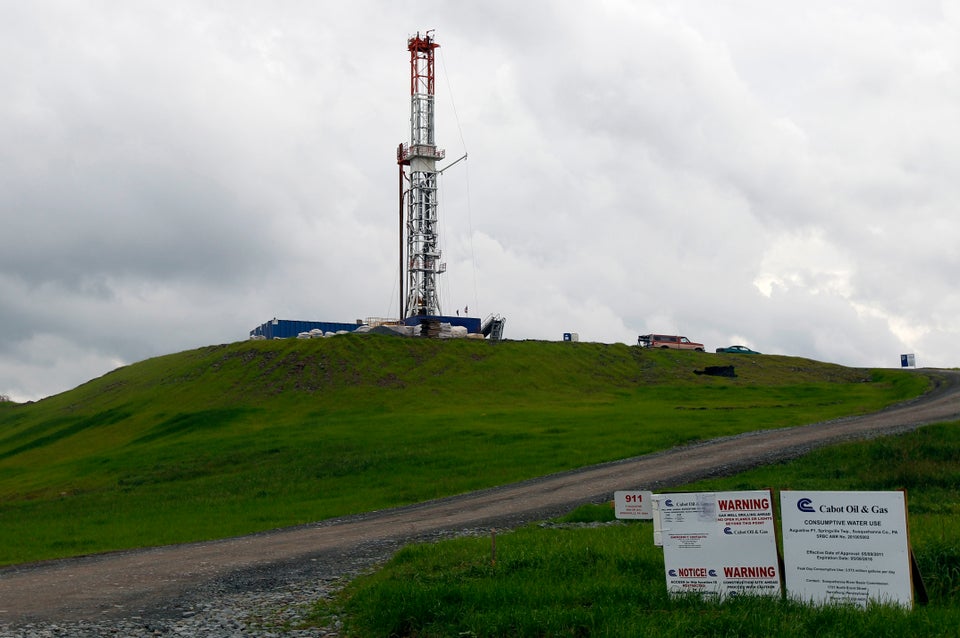
By Laura Zuckerman
SALMON, Idaho, Sept 28 (Reuters) - Government testing of a drinking water aquifer near a tiny Wyoming town has shown concentrations of gases like ethane and propane and diesel compounds, but a natural gas company said it did not cause the contamination.
A report by the U.S. Geological Survey showed petroleum-based pollutants in samples from a monitoring well in the aquifer adjacent to Pavillion, Wyoming, which is at the center of a national debate over hydraulic fracturing, or fracking.
A draft study released in December by the Environmental Protection Agency linked fluids used in fracking, a drilling method that has unlocked vast shale gas deposits across the nation, to pollution in the underground formation that supplies drinking water to residents near Encana Corp's gas production wells east of Pavillion.
The findings contradicted claims by gas drillers that fluids from fracking, which injects water, sand and chemicals underground to boost extraction of fuel, have never contaminated drinking water.
Criticism by the oil and gas industry and Wyoming officials of the methods the EPA employed to collect water quality data and regulators' interpretation of the findings prompted recent retesting under a monitoring plan designed by the state, the USGS and the EPA.
Compared to the 2011 EPA study, the USGS results from testing of one of two monitoring wells in the aquifer indicated higher levels of gases like methane, lower levels of diesel-range organics and the absence of such solvents as toluene, an Encana analysis showed.
The EPA is expected in coming days to release its testing of water from two groundwater monitoring wells, several domestic wells and a public well. The data sets are to be submitted for peer review.
The EPA said the groundwater monitoring data in its 2011 report and USGS findings were "generally consistent."
But Encana spokesman Doug Hock said the findings are not equal and singled out USGS for providing "credible data" in research whose "implications are not just for Encana but for the whole industry."
Hock and Simon Lomax, research director of an arm of the Independent Petroleum Association of America, underscored a decision by USGS to discount samples from the second of two monitoring wells because of concerns that low water quantity and other factors might skew results.
"The USGS effectively disqualified one of the EPA's two monitoring wells," Lomax said in a statement.
He pointed to a March 1 letter by Donald Simpson, director of the Bureau of Land Management office in Wyoming, that recommended the installation of additional monitoring wells for a "larger and much more robust study effort and investment prior to drawing any conclusions, particularly in the case about the role of hydraulic fracturing use in development of the oil and gas resource."
Encana's Hock said the Canadian company denies the pollution in Pavillion is related to its operations.
But Rob Jackson, professor of environmental sciences at Duke University, said his review of USGS data shows it is consistent with EPA's initial results, "which suggested the contamination at the site from fracking is a real possibility."
Jackson, co-author of a peer-reviewed paper that showed fracking in the Marcellus shale in Pennsylvania did not pollute adjacent drinking water wells with brine, said the report by the USGS should quiet criticism of the EPA.
"You can't say that EPA botched the job if USGS goes on and gets similar numbers," he said.
Jackson said it was difficult to account for the presence of hydrocarbons like ethane and propane without a fossil fuel source.
The financial stakes are high in the battle over tainted water in a state where the oil and gas industry last year paid $2.4 billion in taxes and royalties, said John Robitaille, vice president of the Petroleum Association of Wyoming.
But for retired rancher Jeff Locker - one of two dozen residents near Pavillion advised by federal health officials not to drink from domestic wells impaired by pollutants like methane - the costs have all been personal.
"I'm not a scientist. All this fighting over testing has been a frustration to me. All I know is our quality of life has been taken away," he said.

